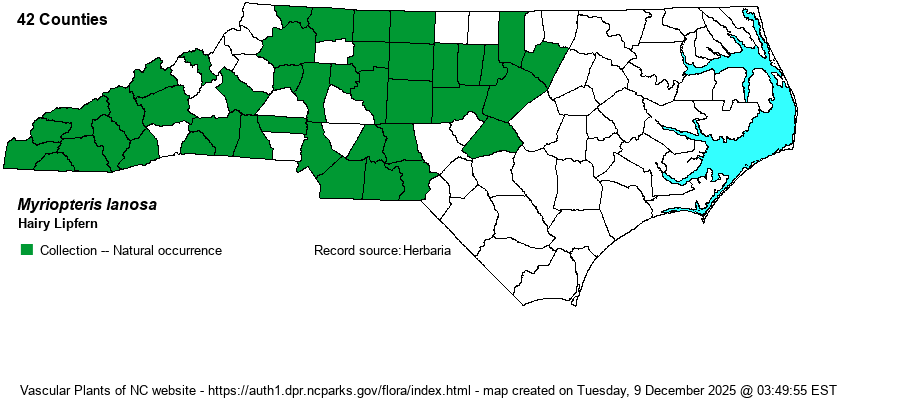| Section 2 » Family Pteridaceae |
Show/Hide Synonym
| taxonName | relationship | relatedTaxonName | relatedTaxonRefText | relComments |
|---|
|
| Myriopteris lanosa | = | Cheilanthes lanosa | | | | Myriopteris lanosa | = | Cheilanthes lanosa | Gleason and Cronquist (1991) | | | Myriopteris lanosa | = | Cheilanthes lanosa | Flora of North America (1993b, 1997, 2000, 2002a, 2002b, 2003a, 2004b, 2005, 2006a, 2006b, 2006c, 2007a, 2009, 2010) | | | Myriopteris lanosa | = | Cheilanthes lanosa | Gleason (1952) | | | Myriopteris lanosa | = | Cheilanthes lanosa | | | | Myriopteris lanosa | = | Cheilanthes lanosa | Kartesz (1999) | | | Myriopteris lanosa | = | Cheilanthes lanosa | | | | Myriopteris lanosa | = | Cheilanthes lanosa | Radford, Ahles, and Bell (1968) | | | Myriopteris lanosa | = | Cheilanthes lanosa | Small (1933, 1938) | | | Myriopteris lanosa | = | Cheilanthes lanosa | | | | Myriopteris lanosa | = | Cheilanthes lanosa | Flora of Virginia | | | Myriopteris lanosa | = | Cheilanthes lanosa | Wofford (1989) | | | Myriopteris lanosa | = | Cheilanthes lanosa | Wunderlin & Hansen Flora of Florida (3) | | | Myriopteris lanosa | = | Cheilanthes lanosa | Flora of West Virginia | | | Myriopteris lanosa | = | Cheilanthes lanosa | Gastony & Rollo (1998). [also see Argyrochosma and Astrolepis] | | | Myriopteris lanosa | = | Cheilanthes vestita | Fernald (1950) | | | Source: Weakley's Flora |
|
| Author | (Michaux) Grusz & Windham | |
| Distribution | Limited to the Mountains and Piedmont, with scattered populations over both of these provinces.
This is an Eastern species, from CT west to WI, south to central GA and OK, with a few scattered records farther southward. It is absent from the Coastal Plain. | |
| Abundance | Infrequent across the Mountains and Piedmont, rarely locally fairly common. Scarce in the far northeastern Piedmont. | |
| Habitat | This is a species limited to rock outcrops, both on flat surfaces (such as around granitic flatrocks) and on near-vertical ones, such as cliffs. The rocks can be of a great array of types, though it favors calcareous or mafic rocks, less so on somewhat felsic ones such as granite. The similar M. tomentosa often grows with it on the more neutral to high pH soils around calcareous or mafic rocks but is mostly absent around granitic rocks (with their acidic soil). |
| Phenology | Fruits from June to September. | |
| Identification | This is a somewhat small fern of rock surfaces, with a narrow blade. The stipe is blackish and wiry, but still quite hairy/hirsute, about 4 inches long, but shorter than the blade, which is about 6 inches long but barely 1.5 inches wide. The blades are quite hairy, especially below, bipinnate-pinnatifid, at times almost tripinnate. There are only about 7-10 pairs of pinnae, green above, mostly opposite or sub-opposite. The sori are in a row along the margins of the pinnules on the blade underside, though the decurved (rolled-under) leaf margins do not cover up sight of them (as in the more rolled-under leaves of M. tomentosa). This latter species often grows near M. lanosa on the same rocks, but that species has a pale whitish-green (and very hairy) frond, stipe and rachis with some flattened scales plus hairs, versus no such scales in M. lanosa; more obvious is the strongly rolled-under leaf margins that typically hide the sori from view. | |
| Taxonomic Comments | The former NC species in the genus Cheilanthes have recently been moved over to the genus Myriopteris.
| |
| Other Common Name(s) | None | |
| State Rank | S4 | |
| Global Rank | G5 | |
| State Status | | |
| US Status | | |
| USACE-agcp | | |
| USACE-emp | | |

